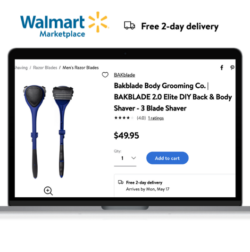Table of Contents
** Minutes
What are the benefits of selling on Walmart Marketplace?
Selling on Walmart Marketplace can boost sales, if you have the right logistics strategy in place
6 steps to start selling on Walmart Marketplace
Walmart Marketplace seller best practices
How to manage increases in order volume
Walmart is one of the most recognisable companies in the world. In fact, it’s the world’s largest company by revenue.
Walmart, historically known for their brick-and-mortar stores, launched Walmart Marketplace in 2009. Though the majority of their sales still come from in-person sales, Walmart.com has gained a lot of traction in recent years — even as they compete with Amazon.
Former Walmart Ecommerce CEO, Marc Lore said, “In today’s world of ecommerce, two-day free shipping is table stakes.” In December 2020, Walmart expanded the Walmart+ membership to include free next-day and two-day shipping no matter the cart value, removing the previous $35 minimum.
Walmart Marketplace is a great channel to expand into and grow your online brand. In this article, you will learn:
- The benefits of selling on Walmart Marketplace
- How to get started step-by-step
- Walmart.com selling best practices
What is Walmart Marketplace?
Walmart Marketplace is an online platform that connects third-party sellers with customers shopping on Walmart.com.
Serving as a place to boost sales by expanding brand recognition and getting in front of more shoppers, many brands are selling on Walmart Marketplace. In fact, more than 5,000 sellers have joined the platform since the retail giant announced its partnership with Shopify last year.
What are the benefits of selling on Walmart Marketplace?
Online buyers prefer online marketplaces, as they can easily find a wide range of products all in one place. Selling on Walmart Marketplace gets your brand and products in front of more customers, and you also get to take advantage of Walmart’s fast shipping capabilities.
Here is an overview of the benefits of selling on Walmart Marketplace.
Reach a wider audience
Multichannel retailing allows you to branch off from only selling products on your online store, and online marketplaces are a great place to to reach a wide range of customers.
Walmart is a household name that has more than 120 million Walmart.com visitors every month. By listing products on Walmart Marketplace, you can get in front of more customers, increase brand visibility, and quickly boost sales.
Simple Walmart pricing structure
Walmart Marketplace has an easy-to-understand pricing structure that has no setup charges, monthly fees, and per-order transaction fees. What you will need to pay is a referral fee for every complete order. This is a simple fee that varies based on products and is usually 15%, but it’s based on what you sell.
If you have all of the right materials, the application process should only take you 10-15 minutes. Then you can get approved to be a part of Walmart Marketplace. With this simple pricing structure, getting started on Walmart.com is low-risk.
Multiple shipping options
Walmart Marketplace offers different shipping options to offer your customers:
- Value shipping
- Standard shipping
- Expedited shipping
- Next-day shipping
- Freight shipping
Walmart Marketplace’s shipping templates and options are completely customisable to your brand. To meet customer expectations around fast last-mile delivery, Walmart Marketplace offers a free TwoDay Delivery program, which enables fast delivery of your products in two days. In addition, your products will be tagged and badged on the website featuring the fast delivery time.
Though it’s not required to opt-in to the program, the TwoDay Delivery program attracts more customers and reduces cart abandonment rate. Walmart recommends offering both standard and expedited shipping options, so customers have the option to choose.
Selling on Walmart Marketplace can boost sales, if you have the right logistics strategy in place
Selling on Walmart Marketplace takes more than simply showcasing product. To boost sales and win over customers, you will need to establish a strong ecommerce logistics strategy.
To be a successful third-party seller on Walmart Marketplace, you will need to establish a multichannel inventory management strategy, which includes:
- Tracking inventory in real time across channels
- Inventory forecasting
- Reporting and analytics tools
Another component of logistics is the ecommerce fulfilment process: the picking and packing of orders and preparing them for shipment. Sellers that don’t want to deal with handling Walmart Marketplace fulfilment themselves can outsource fulfilment entirely.
A third-party logistics (3PL) provider can offer a full suite of fulfilment services, from warehousing to automated shipping.
Note: ShipBob is an official 3PL partner of Walmart and is part of Walmart’s TwoDay delivery program. ShipBob integrates with Walmart Marketplace to display Free 2-day delivery badging and fulfil 2-day orders for approved Walmart Marketplace sellers. (ShipBob also fulfils Walmart Marketplace orders outside of the TwoDay delivery program.)
6 steps to start selling on Walmart Marketplace
To start selling on Walmart Marketplace, there are a few simple steps to take, starting with filling out an application. Once you submit an application with as much information as possible, you’ll be able to get started selling on Walmart.com in no time.
These steps include:
- Application to Walmart marketplace
- Business registration
- Setting up your partner profile
- Account item setup
- Test run on your online store
- Launching your account
1. Walmart Marketplace seller application
The first thing you will need to do is head over to marketplace.walmart.com and fill out the application form, which should only take you about 15 minutes to complete. During this process, you will be asked for a range of information; it’s important to provide as much information as possible to make the process quicker.
The requirements needed for your application include:
- US Business Tax ID (it will not accept SSN)
- W9 or W8 and EIN Verification Letter from the Department of Treasury that verifies your US business address or place of physical operations
- Planned integration method for your product catalogueueue (bulk upload, API, solution provider)
- Primary product categories, catalogueueue size, and related information
- Your catalogueueue cannot include any products from Walmart’s Prohibited Products Policy
- Evidence of your brand’s history of marketplace or ecommerce success
You should hear back from Walmart Marketplace shortly after. Be prepared as they might have further questions about your application.
2. Business registration
After providing all of the previous information and after you’ve been approved, you will receive an email that asks you to register your business and provide further information.
When registering your company, you will need to provide your company’s name and address to complete your profile. Along those lines, you will also need to register your account username and password which will be created through your profile.
You will then need to sign the terms and conditions and the ‘Walmart Retailer Agreement’ before moving forward.
3. Setting up your partner profile
Once you set up your partner profile, you will have access to the Walmart’s Seller Centre dashboard.
For this step, you will need to fill out your company name, description, upload your company logo, and also the following important considerations:
Shipping options
At this point, you will select the shipping options you want to offer customers and the locations that you will ship to. The default shipping methods include Value, Standard, Expedited, and Next Day.
If you want to further customise your shipping strategy, you’ll be able to once your store’s setup is complete.
Returns management
You will need to establish returns management process before you start selling. A product return does not always need to lead to a bad customer experience or lost profit. The first step in the returns management process is to create an ecommerce returns policy that provides clear information for your customers.
Tax requirements
To fulfil the requirement of tax forms, you will need to fill out and submit a W-9 form, which will require a range of information including your name, address, and taxpayer identification number.
Payment processing
For your brand to receive its payments, you will need to register with either Payoneer or Hyperwallet. These are the two websites Walmart has partnered with for you to receive your payments.
4. Conduct a test run
Once you’ve completed all of the above steps, you will need to give your online store a test run. Test an order by publishing two to three items and placing your own orders. (Note: you won’t have to ship these items.)
When you successfully add all the items you want to sell, they will automatically be moved to ‘stage’ status, which means they won’t show up live. During this stage, check your order confirmation, cancellation, shipping, and refund workflows.
Once everything is validated and working as expected, Walmart will complete a final review process before going live.
5. Start selling on Walmart.com
The final step is launching your account. Once you fill out all of the requirements, the Walmart Marketing team will review your profile, products, information, and your products will be searchable within 24-48 hours.
Walmart Marketplace seller best practices
When becoming a part of Walmart Marketplace, it is important to take advantage of what it has to offer. Here are some ways you can take selling on Walmart Marketplace to the next level.
1. Select the best fulfilment options for your needs
How you manage retail fulfilment for Walmart orders is entirely up to you. You have the option to fulfil orders in-house or partner with a fulfilment provider.
Walmart Fulfilment Services (WFS) also offers fulfilment services. WFS fees are based on a fixed monthly storage fee and a fulfilment fee based on the weight of the package alone (exceptions to this are for apparel and HAZMAT items).
Walmart’s fulfilment network is able to charge by weight alone for their fulfilment fee by limiting the maximum size of accepted products to 25″ x 20″ x 14″. This pricing structure can be advantageous for some sellers but limiting for others.
You also have the option to outsource fulfilment to a 3PL like ShipBob, who can store, pick and pack, and ship orders placed across sales channels, including Walmart Marketplace.
An official 3PL partner of Walmart and part of Walmart’s TwoDay delivery program, ShipBob integrates with Walmart Marketplace to display Free 2-day delivery badging and fulfil 2-day orders for approved Walmart Marketplace sellers (along with other Walmart Marketplace orders).
2. Optimise your online listings
With so many sellers on Walmart Marketplace, it’s important that all of your live Walmart Marketplace listings are optimised fully to attract the right customers.
Walmart Marketplace offers different services such as their Listing Quality Dashboard to help with the success of your brand on the site. Using this feature, you will be able to gain insight on your listing to help you further optimise your listing by doing the following:
- Filter by priority to view which items have the biggest potential GMV lift.
- Quickly correct price mismatches or incorrectly assigned product types.
- Read item-level reviews.
- Export up to 10k items.
3. Walmart integration across platforms
Walmart Marketplace integrates with leading ecommerce platforms like BigCommerce, Shopify, WooCommerce, and more to automate fulfilment and streamline your logistics.
Walmart partners with full-service solution providers that can offer you the support you need. For instance, you can partner with ShipBob to manage inventory across distribution centres for Walmart orders and other sales channels.
If you use other tools and systems for inventory tracking, accounting, and payment processing, Walmart offers integrations with a wide range of ecommerce solutions. This makes it easy to plug Walmart Marketplace into your existing tech stack.
4. Set up your returns management program
Walmart Marketplace has an Enhanced Returns program that gives your customer the ease of returning orders. However, if you work with a 3PL, you can set up your own custom return process to streamline returns — especially if you sell across multiple channels.
For example, ShipBob can help you keep track of your ecommerce returns and keep all of the information in one place. If you and your team choose how you want your product to be processed, the ShipBob team can take it from there.
5. Invest in sponsored products
Walmart Marketplace allows sellers to advertise specific products and set up campaigns at any time and budget, targeting any keywords. Although paying to feature your products at the top of the site costs money, it can help you reach a wider audience, faster.
Sponsored products on the site are cost-per-click (CPC) ads, which means you only pay when a customer clicked on your ad. These ads can really help maximise your listings and stand out.
6. Boost pages with Walmart SEO
If you notice that a few of your pages are performing poorly in rankings when searching for your product, you can try boosting visibility using a few Walmart SEO tips and tricks to rank higher for important keywords and products. Here are a few:
- Using a high-quality photo for your product
- Enabling 2-day delivery
- Pricing products competitively
- Highlighting key product features
- Creating specific product names
Boosting your Walmart.com SEO can help you continue to reach a wider audience and make the most out of your listings, while keeping CPC spend low.
7. Promote Walmart reviews
Having more than 50 customer reviews per product has proven to increase conversions by 4.6%. Be sure to ask your customers to write reviews whenever possible, as getting customer reviews is important for social proof and can easily boost sales.
Walmart will automatically send post-purchase review emails for each item. Once the positive reviews come in, you can use them to market your brand and attract more customers.
How to manage increases in order volume
When selling on a much bigger platform like Walmart Marketplace, you’re given the opportunity to reach more customers and increase sales. Therefore it is important to be prepared for when there is an increase in your order volume in terms of where to store your products and how to send them out in a timely fashion.
ShipBob is a best-in-class fulfilment provider that lets you split inventory across locations to reduce shipping costs and transit times, so you can provide fast, affordable shipping options for your customers.
ShipBob also offers full visibility into the fulfilment process and provides built-in order and inventory management capabilities, data and analytics, and the ability to control inventory across your distribution network all from dashboard.
How ShipBob connects to your Walmart store
Walmart integrates with ShipBob’s technology to easily streamline your order fulfilment process.
You can leverage the power of the world’s largest retailer and the most trusted logistics platform for ecommerce brands to offer your products to millions of Walmart.com shoppers.


Increase Walmart.com conversions with 2-day delivery badges in search results and listings to catch shoppers’ attention.
Shoppers filter products with 2-day delivery and see “2-day delivery” badging in search results under the product price.
A ‘free 2-day delivery’ badge will automatically appear above the “Add to cart’ button for your products, and you can mention 2-day delivery in your product descriptions.
You can connect your Walmart store to ShipBob in minutes, sync your inventory, and choose what fulfilment centre locations to send inventory to. Once ShipBob receives your inventory and orders are placed on Walmart.com, they are automatically sent to ShipBob and to be picked, packed, and shipped.
ShipBob has a network of fulfilment centre locations to provide fast, affordable shipping for your customers.
To learn more about how ShipBob can optimise your Walmart fulfilment process, click the button below.
Walmart Marketplace FAQs
Here are some of the most common questions online brands have about getting started and selling on the Walmart Marketplace.
Does Walmart have third-party sellers?
Yes. Walmart Marketplace is designed for third-party sellers. The company is looking for brands that can complement its own products.
How much does it cost to sell on Walmart Marketplace?
Walmart Marketplace does not require a service fee subscription to sell your products on the site, but you will be charged a referral fee that typically is around 15%.
Which is the best shipping option for marketplace sellers?
There are different shipping options for sellers on Walmart Marketplace, but it is recommended that sellers participate in two-day or three-day shipping to meet customer expectations.
How do returns work on Walmart Marketplace?
When making a return from a purchase made on Walmart Marketplace, the customer will need to learn how to return by mail, find a local store to return an item in person, or contact Customer Care for help getting a shipping label.



